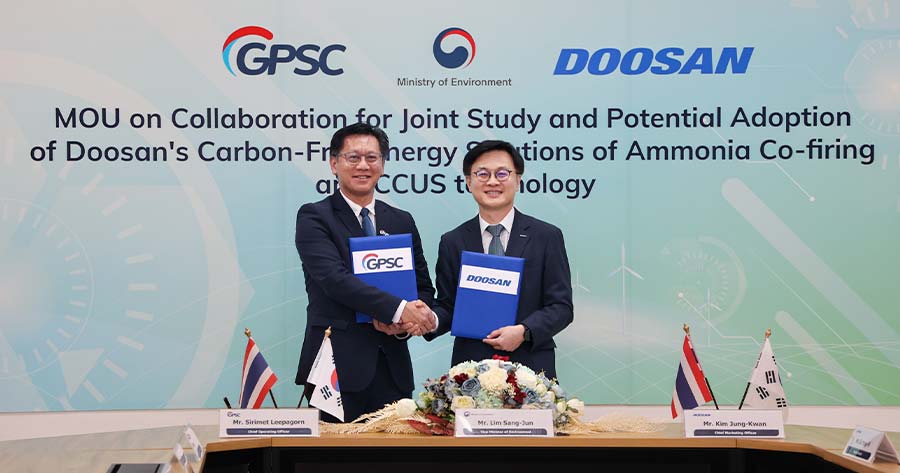GPSC and Doosan Enerbility of Korea entered into an MOU to establish a comprehensive partnership framework aimed at adoption of Ammonia Co-firing, CCUS Technology and Carbon Free Energy Solutions in order to enhance the efficiency of the power plants of all types. The duration of this joint study is 3 years, and it is intended to reduce the emissions of carbon dioxide into the atmosphere, which is aligned with the company’s main strategies to develop the S-Curve businesses and energy innovations, and then to achieve the target of Net Zero emissions by 2060.
Mr. Sirimet Leepagorn, Chief Operating Officer of Global Power Synergy Public Company Limited or GPSC, the innovative power flagship of PTT Group, revealed that, on 19 June 2024, GPSC signed the memorandum of understanding (MOU) with Mr. Jung-kwan Kim, Executive Vice President and Chief Marketing Officer of Doosan Enerbility Company Limited, Korea’s leading plant expert of the power and water industry, offers energy solutions for thermal power, nuclear power, renewable energy and carbon-free solutions. This MOU ceremony was presided over by Mr. Sang-jun Lim, Vice Minister of Environment (MOE) of the Republic of Korea. The MOU is designated to study the feasibility for potential adoption of Fuel Shifts & Hybridization, CCUS technology (Carbon Capture, Utilization & Storage) and Carbon Free Energy Solutions that can lead us for the decarbonization of our electricity and steam productions from existing power plants that will help to alleviate the release carbon dioxide into the atmosphere. Hence, it is considered an important milestone to produce cleaner energy to our customers. Thereby, it is projected that the joint feasibility study will take approximately three years, from 2024 to 2026.
Mr. Jung-kwan Kim, Executive Vice President and Chief Marketing Officer of Doosan Enerbility, said that Doosan Enerbility’s carbon-free energy solutions, such as our patented ammonia co-firing technologies and CCUS technology, will be an optimal solution that is in alignment with the net zero roadmap. In addition, the emphasis is also placed on the technology of CCUS because it is suitable for potential installation for GPSC’s power plants and it can absolutely improve our carbon intensity, corresponding to the goals of Net Zero Emissions and sustainability business of GPSC.
“The joint feasibility studies of carbon-free solutions and CCUS technology are a highly significant addition to our expansion of renewable energy development, which is already one of the core GPSC’s businesses. Our goal is to explore additional opportunities to decarbonize for the cleaner production of electricity and steam, aligning with GPSC’s main mission in helping alleviate the issues of global warming. The feasibility study assisted by the experts from Doosan Enerbility and support from MOE will enable GPSC to achieve the target of Net Zero Emissions by 2060,” Mr. Sirimet said.
In reference to this collaboration, both parties will jointly conduct the feasibility study, which covers the topics of ammonia co-firing, hydrogen and CCUS technologies. This includes the exchange of technological knowledge with the intention to prepare the specifications for future plant retrofits. Such carbon-free solutions and CCUS are considered as new technologies that require specialized study to adopt into our existing conventional power plants to minimize the carbon dioxide released from the production of electricity and steam. This will play a pivotal role in the supply of energy to the industrial customers who require cleaner energy in their production process. Furthermore, the combined effort herein is complying to the strategies of GPSC to operate business for sustainability, devise clean energy innovations, and pave ways for the new S-Curve energy businesses so that the company can boost its competitiveness in the safe and eco-friendly clean energy innovative projects being pursued within the country.



